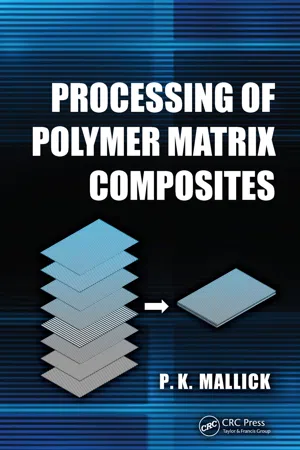
- 342 pages
- English
- ePUB (mobile friendly)
- Available on iOS & Android
About This Book
Polymer matrix composites are finding increasing number of applications due to their high weight-saving potential as well as unique characteristics, such as high strength-to-density ratio, fatigue resistance, high damping factor, and freedom from corrosion. While many textbooks are available on the mechanics of polymer matrix composites, few cover their processing. Processing of Polymer Matrix Composites fills this gap. The book focuses on the major manufacturing processes used for polymer matrix composites and describes process details, process parameters and their effects on properties and process-induced defects, and analytical and experimental methods used for understanding process conditions. The book describes fibers, thermosetting and thermoplastic polymers, and interface characteristics that are important from the standpoint of both design and processing. It also emphasizes the applications of process fundamentals for both continuous fiber and short fiber polymer matrix composites. In addition the book considers quality inspection methods, tooling, and manufacturing costs and environmental and safety issues.
Frequently asked questions
Information
1Introduction
Material | Density (g/cm3) | Tensile Modulus (GPa) | Tensile Strength (MPa) | Tensile Modulus-to-Weight Ratio (106 m) | Tensile Strength-to-Weight Ratio (103 m) |
|---|---|---|---|---|---|
SAE 1010 steel (cold worked) | 7.87 | 207 | 365 | 2.68 | 4.72 |
AISI 4340 steel (quenched and tempered) | 7.87 | 207 | 1722 | 2.68 | 22.3 |
6061-T6 aluminum alloy | 2.70 | 69 | 310 | 2.60 | 11.7 |
7178-T6 aluminum alloy | 2.70 | 69 | 606 | 2.60 | 22.9 |
Ti-6Al-4V titanium alloy | 4.43 | 110 | 1171 | 2.53 | 26.9 |
High-strength carbon fiber–epoxy composite (unidirectional) | 1.55 | 137.8 | 1550 | 9.06 | 101.9 |
High-modulus carbon fiber–epoxy composite (unidirectional) | 1.63 | 215 | 1240 | 13.44 | 77.5 |
E-glass fiber–epoxy composite (unidirectional) | 1.85 | 39.3 | 965 | 2.16 | 53.2 |
Kevlar 49 fiber–epoxy composite (unidirectional) | 1.38 | 75.8 | 1378 | 5.60 | 101.8 |
Carbon fiber–epoxy composite (quasi-isotropic) | 1.55 | 45.5 | 579 | 2.99 | 38 |
SMC composite (isotropic) | 1.87 | 15.8 | 164 | 0.86 | 8.9 |
Table of contents
- Cover
- Half Title Page
- Title Page
- Copyright Page
- Dedication
- Contents
- Preface
- Chapter 1 Introduction
- Chapter 2 Fiber Architecture
- Chapter 3 Matrix Materials
- Chapter 4 Processing Fundamentals
- Chapter 5 Bag Molding Process
- Chapter 6 Compression Molding
- Chapter 7 Liquid Composite Molding
- Chapter 8 Filament Winding
- Chapter 9 Pultrusion
- Chapter 10 Forming of Thermoplastic Matrix Composites
- Chapter 11 Joining and Repair
- AppendixHealth and Safety Issues
- Index